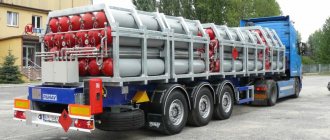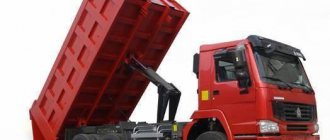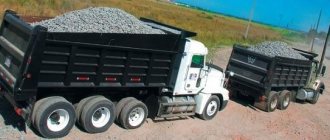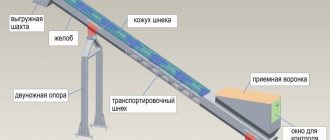Transportation of goods is regulated by transportation rules. They indicate the standard parameters and weight of the items that need to be delivered. Material assets that exceed them in length, width, height and weight are considered non-standard.
In this case, logistics companies offer to place an order for oversized or bulky transportation. When faced with the problem of transporting non-standard equipment or machinery for the first time, it is not always clear which cargo is classified as large and oversized, and how their transportation differs. Let's talk about this in more detail in the article.
Oversized cargo: definition
This term refers to a vehicle (with or without cargo) that exceeds in its overall dimensions the values established by regulatory documents. Thus, the transport affinity should not exceed 20 m in length, 2.55 m in width, and 4 m in height. With such dimensions, the total weight of the vehicle and cargo should not exceed 38 tons.
It is clear that lighter and smaller cargo is easier to transport and, accordingly, cheaper. Therefore, transportation of large-sized cargo is considered simpler if the dimensions are within the following limits: length no more than 2 m extends beyond the edges of the vehicle, width - up to 3.5 m, height - up to 4.5 m.
74-70-69
Transportation of large and heavy cargo in urban, suburban and intercity traffic is carried out in accordance with the Rules for the transportation of goods by road (approved by Decree of the Government of the Russian Federation of April 15, 2011 No. 272), issued in pursuance of Federal Law of November 8, 2007 No. 259 -FZ “Charter of Motor Transport and Urban Ground Electric Transport” (hereinafter referred to as the Charter) and have the same scope as the Charter, i.e. regulate relations arising in the provision of services by road transport.
In the case of transportation of large and heavy cargo carried out to meet the own needs of legal entities and individuals on vehicles that they legally own, contractual relations do not arise. Therefore, these transportations are still the scope of application of the Instructions for the transportation of large-sized and heavy cargo by road on the roads of the Russian Federation (approved by the Ministry of Transport of Russia on May 27, 1996). By Order of the Ministry of Transport of Russia dated July 24, 2012 No. 258, changes were made to this Instruction.
The same order approved the Procedure for issuing a special permit for the movement of a vehicle on highways carrying large-sized and heavy cargo, provided for in Article 31 of the Federal Law of November 8, 2007 No. 257-FZ “On highways and road activities in the Russian Federation and on amendments to certain legislative acts of the Russian Federation.”
Rules for the transportation of oversized cargo by road
Transportation of oversized items is allowed only in cases where a number of conditions are met (clause 23.3. Traffic rules ):
- The load does not impair the driver's visibility;
- Does not have a negative impact on vehicle stability;
- Does not cover reflectors, lighting devices, identification marks, does not interfere with the perception of hand signals given to the driver;
- Does not create noise, does not raise dust during transportation, does not harm the road or the environment.
If one of these conditions is violated while driving, the driver’s task is to eliminate the violation. If for any reason this is not possible, you must stop driving, otherwise a fine will be issued for transporting large cargo.
Penalty table
| Article of the Code of Administrative Offenses of the Russian Federation | Offense | Sanctions |
| 12.21.1 part 1 | Transportation of large and heavy cargo without special permission and a special pass in the event that obtaining such a pass is mandatory, as well as with deviation from the route specified in the special permit | fine: per driver from 2000 to 2500 rubles. or deprivation of the right to drive a vehicle for a period of 4 to 6 months, for officials from 15,000 to 20,000 rubles, for legal entities from 400,000 to 500,000 rubles. / confiscation of driver's license, from July 1, 2008. – vehicle detention |
| 12.21.1 part 2 | Transportation of large-sized cargo exceeding the dimensions specified in the special permit by more than 10 centimeters | fine: per driver from 1500 to 2000 rubles. or deprivation of the right to drive a vehicle for a period of 2 to 4 months, for officials from 10,000 to 15,000 rubles, for legal entities from 250,000 to 400,000 rubles. / confiscation of driver's license, from July 1, 2008. – vehicle detention |
| 12.21.1 part 3 | Transportation of heavy cargo exceeding the permitted maximum weight or axle load specified in a special permit by more than 15 percent | fine: for a driver from 1,500 to 2,000 rubles, for officials from 10,000 to 15,000 rubles, for legal entities from 250,000 to 400,000 rubles. |
| 12.21.1 part 4 | Violation of the rules for the transportation of large and heavy cargo, except for the cases provided for in parts 1 – 3 of this article | fine: for a driver from 1000 to 1500 rubles, for officials from 5000 to 10000 rubles, for legal entities from 150000 to 250000 rubles. |
There are also special identification marks that must be installed on the cargo in the following cases (clause 23.4. Traffic rules): “If the cargo exceeds the dimensions of the vehicle and protrudes from the rear or front by more than 1 meter, or from the side by more than 40 centimeters, it must be marked with the “Oversized cargo” sign. » If transportation occurs at night or in low light conditions, then in addition to the rules described above, the following must also be observed: attach a white reflector or flashlight to the load in front; There is a red reflector at the back. Failure to comply with these rules will compromise traffic safety and may result in a fine for oversizing .
There are specially developed rules that come into force in cases where the vehicle, with or without cargo, exceeds 2.55 meters in width, 4 meters in height, and 20 meters in length. Identification marks must be installed on the vehicle
“Oversized cargo” signs and flashing lights (colors yellow and orange).
The following driving features relate to speed limits. Thus, the speed on roads should not exceed 60 kilometers per hour and 15 km/h when driving on bridges. In addition, the driver is prohibited from deviating from the pre-planned route, which is agreed upon with special authorities.
RULES FOR CARGO TRANSPORTATION
Transportation of large and heavy cargo
Transportation of large and heavy cargo on roads is carried out in accordance with the permitting procedure, based on the bearing capacity of roads and structures. At the same time, the goods allowed for transportation, depending on their weight and size, are divided into two categories. In this case, the cargo means the vehicle itself (loaded or not) with the permissible:
- axial load on each axle;
- dimensions in height, width or length.
Accordingly, a heavy load means a vehicle whose mass (with or without cargo) or axial mass exceeds at least one of the established parameters, and a large load means a vehicle whose dimensions (with or without load) in height, width or length exceed at least one of the established values.
The main regulatory document regulating the transportation of large and heavy cargo is the Instruction of the Ministry of Transport of Russia and the Ministry of Internal Affairs of Russia on the transportation of large and heavy cargo by road on the roads of the Russian Federation dated May 27, 1996 (as amended on November 12, 2012). In addition, large and heavy cargo must be transported taking into account the requirements of the Road Traffic Regulations of the Russian Federation, cargo transportation rules and additional requirements specified in the cargo transportation permit.
Transportation of large and heavy cargo by road can only be carried out on the basis of special permits issued in the prescribed manner.
Applications for permits for the transportation of large or heavy cargo, depending on the type of intended transportation (international, interregional or local), the category of large and heavy cargo and the location of the carrier’s vehicle, are submitted to the relevant road authorities from the territory whose service the route begins vehicle movement.
Applications for obtaining permits for international transportation of large and heavy cargo of all categories are submitted to the Ministry of Transport of the Russian Federation or its division (authorized body).
Applications for permits to carry out interregional and local transportation along a route passing entirely or partially along federal roads, for large and heavy cargo of all categories, are submitted to the federal highway management body closest to the point from which the transportation route begins.
Applications for obtaining permits for interregional and local transportation of large-sized and heavy cargo of all categories along a route passing entirely along the roads of objects of the Russian Federation are submitted to the territorial highway authorities at the location of the carrier’s vehicle.
An application for permission to transport large or heavy cargo is submitted to the authority authorized to issue the relevant permits.
The information provided in the application is certified by the signature of the head or deputy head and the seal of the organization or the signature of the individual carrying out the transportation.
An application for cargo transportation is submitted in the form established by the Instructions for the transportation of large-sized and heavy cargo by road. It must contain all the information necessary for the organizations coordinating the transportation about the nature and category of the cargo, the weight parameters and dimensions of the vehicle, the expected duration of transportation, the route and other information.
Depending on the category of cargo transported, the type and nature of transportation, owners or users of vehicles transporting large-sized and heavy cargo may receive one-time permits or permits for a certain (specific) period.
One-time permits are issued for one transportation of cargo along a certain (specific) route within the time period specified in the permit.
Permits for a certain period are issued only for the transportation of goods of the first category for a period of 1 to 3 months or for a certain amount of this type of transportation during the time specified in the application, but not more than for 3 months.
Along with the application for a permit for the transportation of large and heavy cargo of the second category, a diagram of the road train is presented showing all the vehicles involved in the transportation, the number of axles and wheels on them, the relative position of the wheels and axles, the distribution of load along the axles and on individual wheels with taking into account possible uneven distribution of load along the length of the axle.
Coordination of all transportation of large and heavy cargo along the entire route with highway authorities, balance holders of artificial structures and communications, railway departments (bridges, overpasses, railway crossings, metro lines, underground pipelines and cables, overhead power supply and communication lines, etc.) etc.), services, authorized bodies of a constituent entity of the Russian Federation or local government bodies manage the road network of cities and other populated areas by the road management body that issues the permit.
After receiving permission, the carrier coordinates this transportation with the traffic police of the Ministry of Internal Affairs of the Russian Federation. Municipal Department of Internal Affairs. ATC of the constituent entities of the Russian Federation, in the territory whose services the transportation route begins (Appendix 3 to this paragraph). Upon approval, special requirements for the procedure for transporting cargo are determined, based on the conditions for ensuring road safety, and a special pass is issued, granting the right to drive the vehicle. The pass is placed in the lower right corner of the vehicle's windshield.
Transportation of large and heavy cargo of the second category in populated areas is carried out during the period of least traffic intensity, and outside populated areas - during daylight hours. At night on roads outside populated areas, as well as during heavy traffic during daylight hours, transportation is permitted only if the cargo is accompanied.
When agreeing on a permit to transport cargo, the traffic police determines the need and type of escort.
Support can be provided:
- cover vehicle and (or) tractor;
- patrol car of the State Traffic Inspectorate.
Accompaniment by a cover vehicle is mandatory in all cases when:
- the width of the loaded vehicle exceeds 3.5 m;
- the length of the road train is more than 24 m;
- in other cases, when the permit in the column “Special traffic conditions” states that movement through any artificial structure is permitted alone, or other conditions are indicated that require prompt changes in the organization of traffic on the cargo transportation route.
Cover vehicle(s), as well as tractors (depending on the cargo being transported and road conditions) are allocated by the cargo carrier or shipper.
Participation in the escort of a State Traffic Inspectorate patrol car is necessary if:
- the width of the vehicle exceeds 4.0 m;
- the length of the road train exceeds 30.0 m;
- when moving, the vehicle is forced to at least partially occupy the lane of oncoming traffic;
- during the transportation process, it is assumed that there is a need for prompt changes in traffic organization in order to ensure travel safety;
- the cargo belongs to the second category.
In other cases, the need for escort is determined by the traffic police based on road conditions, traffic intensity and the composition of the traffic flow.
A car with an orange or yellow flashing light is used as a cover vehicle.
The cover vehicle should move ahead at a distance of 10-20 m with a ledge on the left side in relation to the escorted vehicle transporting large and heavy cargo, i.e. in such a way that its width extends beyond the dimensions of the accompanying vehicle. When driving across bridge structures, the movement of the cover vehicle (distance, position on the bridge, etc.) is carried out in accordance with the agreed pattern.
The speed of movement during the transportation of large and heavy cargo is set by the State Traffic Safety Inspectorate, taking into account the requirements of other organizations that have approved the transportation.
The speed of travel should not exceed 60 km/h on roads, and 15 km/h on bridge structures. In this case, the permitted traffic mode may vary on different sections of the route.
When transporting large and heavy cargo, it is prohibited:
- deviate from the established route;
- exceed the speed specified in the permit;
- drive during icy conditions, as well as when meteorological visibility is less than 100 m;
- move along the side of the road, unless such an order is determined by the conditions of transportation:
- stop outside specially designated parking areas located off the road;
- continue transportation if a technical malfunction of the vehicle occurs that threatens traffic safety;
- travel on a flight without permission, with an expired or incorrectly executed transportation permit, in the absence of signatures of the officials indicated in it;
- make additional entries in the permit for the transportation of large or heavy cargo.
If during movement circumstances arise that require a change in route, the carrier must obtain permission to move along the new route in the prescribed manner.
The technical condition of vehicles used for transportation must meet the requirements of the Road Traffic Rules, the Basic Provisions for the admission of vehicles to operation and the duties of officials to ensure road safety, the Rules for the technical operation of rolling stock of road transport, manufacturers' instructions, and also Instructions for the transportation of large and heavy cargo.
To transport large-sized and heavy cargo, it is prohibited to use wheeled tractors as tractors on federal roads, and tracked tractors on all roads with improved surfaces.
It is not allowed to transport heavy cargo by a vehicle (tractor) when the weight of the towed trailer (semi-trailer) with the cargo exceeds the technical standards established by the manufacturer.
The braking system of a road train must operate from the brake pedal of the towing vehicle and ensure such a distribution of braking forces between its links that when braking, the possibility of “folding” the road train is excluded.
Tractor vehicles designed to work with trailers must be equipped with a device that allows, in the event of a break in the connecting lines between the tractor and its trailer (semi-trailer), to brake the vehicle with a service or emergency brake.
Trailers (semi-trailers) must be equipped with a parking brake that ensures that a loaded trailer (semi-trailer) disconnected from the vehicle is held on a slope of at least 16% by a service brake acting on all wheels, and a device that provides automatic stopping in the event of a break in the connecting lines with the towing vehicle.
When transporting heavy loads, it is necessary to have at least two wheel chocks for each link of the road train in order to additionally secure the wheels in case of a forced stop on a slope.
The vehicle cabin must be equipped with at least two external rear-view mirrors on both sides, which must provide the driver with sufficient visibility, both in straight and curved motion, taking into account the dimensions of the vehicle and the cargo being transported.
Vehicles transporting large and heavy cargo must be equipped with identification signs “Road train”, “Large cargo” and “Long vehicle” in accordance with the Basic Provisions for the admission of vehicles to operation and the responsibilities of officials to ensure road safety and Traffic rules.
Vehicles transporting large and heavy cargo must be equipped with special light signals (flashing beacons) of orange or yellow color.
If the height of the vehicle is more than 4.0 m, the cargo carrier is obliged to carry out a control measurement of the height under overpasses and other artificial structures and communications along the transportation route.
Monitoring compliance with the rules for the transportation of large and heavy cargo, permissible weight parameters and dimensions of vehicles is carried out by road authorities, the Federal Service for Supervision of Transport and the State Traffic Safety Inspectorate.
Carriers of large and heavy cargo are obliged to:
- comply with the requirements set out in the Instructions for the transportation of large and heavy cargo by road on the roads of the Russian Federation;
- provide, at the request of the traffic police inspector, vehicles for carrying out weight control;
- present, at the request of regulatory authorities, permits for the transportation of large and heavy cargo, licenses and other required documents;
- strictly follow the additional requirements and route specified in the permit;
- prevent damage to road and other engineering structures along the route;
- comply with the requirements of the authorities exercising control over the road transportation of large and heavy cargo, within the powers of these authorities.
Drivers and officials, owners or users of vehicles are liable, in accordance with current legislation, for violating the rules for the transportation of large and heavy cargo and the rules for operating vehicles established by manufacturers.
In case of detention of vehicles carrying large and heavy cargo for violation of established requirements, payment for the vehicle's stay in a paid parking lot is made by the carrier.
If a violation of the established procedure for transporting large-sized or heavy cargo leads to damage to roads, road structures and communications along the route of the cargo, the owners or users of vehicles are obliged, at the request of road authorities or the owners (balance holders) of structures and communications, to compensate them for losses in the manner prescribed by law .
Drivers, owners or users of vehicles have the right to appeal against the illegal actions of officials exercising control over the transportation of large and heavy cargo in the prescribed manner.
Parameters of vehicles of categories 1 and 2
I. Vehicle parameters, if exceeded, it belongs to category 1
1. Classification of motor vehicles (ATS), depending on axial masses, is divided into two groups:
Group A - vehicles with axle masses of the most loaded axle over 6 tons up to 10 tons inclusive, intended for operation on roads of categories I - III, as well as on roads of category IV, the surface of which is built or reinforced for an axle weight of 10 tons.
Group B - vehicles with axle masses of the most loaded axle up to 6 tons inclusive, intended for use on all roads.
2. Axial and total masses of vehicles
2.1. The axial weight of biaxial vehicles and biaxial bogies must not exceed the values given in Table 1.
Table I
| Distance between axles, m | Axial weight for each axle, no more than, t | |
| ATS group A | Group B ATS | |
| Over 2.00 | 10,0 | 6,0 |
| Over 1.65 to 2.00 inclusive | 9,0 | 5.7 |
| Over 1.35 to 1.65 inclusive | 8.0- | 5.5 |
| Over 1.00 to 1.35 inclusive | 7,0 | 5.0 |
| Until 1.00 | 6.0 | 4,5 |
Notes.
1) “*” - for containers - 9.0.
2) It is allowed to increase the axial mass when the distance between the axles of a two-axle bogie for vehicles of group A is over 1.35 to 1.65 m inclusive up to 9.0 tons, if the axle mass per adjacent axle does not exceed 6.0 tons.
3) For vehicles of groups A and B, designed before 1995, with a distance between axles of no more than 1.32 m, axle masses of 8.0 t and 5.5 t, respectively, are allowed.
2.2 Axial weight of three-axle vehicle bogies
should not exceed the values given in table 2.
table 2
| Distance between axles, m | Axial weight for each axle, no more than, t | |
| ATS group A | Group B ATS | |
| Over 5.00 | 10,0 | 6,00 |
| Over 3.20 to 5.00 inclusive | 8,00 | 5,5 |
| Over 2.60 to 3.20 inclusive | 7,5 | 5,0 |
| Over 2.00 to 2.60 inclusive | 6,5 | 4,5 |
| Until 2.00 | 5,5 | 4,0 |
Note. The data given in table. 2 apply to three-axle bogies in which adjacent axles are located at a distance of at least 0.4 m. distances between the extreme axes.
2.3 The total weight of the vehicle must not exceed the values given in Table 3.
Table 3
| Types of PBX | Gross weight, t | Distance between the extreme axles of group A vehicles, not less than, m | |
| group A | group B | ||
| Single cars | |||
| Biaxial | 18 | 12 | 3,0 |
| Triaxial | 25 | 16,5 | 4,5 |
| Four-axis | 30 | 22 | 7,5 |
| Semi-trailer trains (tractor with semi-trailer) | |||
| Triaxial | 28 | 18 | 8,0 |
| Four-axis | 36 | 23 | 11,2 |
| Five-axis and more | 38 | 28,5 | 12,2 |
| Trailed road trains | |||
| Triaxial | 28 | 18 | 10,0 |
| Four-axis | 36 | 24 | 11,2 |
| Five-axis and more | 38 | 28.5 | 12,2 |
Notes.
1) For single vehicles (tractors), the total weight is not allowed to exceed 30 tons.
2) Limit values of the total weight of vehicles are permissible if they are evenly distributed along the axles with a deviation in axle loads of no more than 35.8, and for the front axle no more than 40.8.
2.4 When driving on bridge structures, the total weight of vehicles should not exceed the values given in Table 4.
table 4
| Distance between extreme axes, m | Gross weight, t |
| More than 7.5 | 30 |
| More than 10.0 | 34 |
| More than 11.2 | 36 |
| More than 12.2 | 38 |
Notes.
1) For single vehicles (tractors), the total weight is not allowed to exceed 30 tons.
2) Limit values of the total mass of vehicles are permissible if they are evenly distributed along the axles with a deviation in axle loads of no more than 35.8 tons, and for the front axle no more than 40.8.
3. Dimensions of the vehicle
3.1. The length of the vehicle should not exceed:
— single vehicles and trailers 12.0 m; And
— road trains consisting of “vehicle-trailer” and “vehicle-semi-trailer” - 20.0 m; f,
3.2. The width of the vehicle should not exceed 2.5 m; for refrigerators and isothermal bodies, 2.6 m is allowed.
Protrusions may exceed the permitted width dimensions
— anti-skid devices placed on the wheels;
— rear-view mirrors, awning fastening elements, designed in such a way that they can deviate, while entering the clearance;
- tires near contact with the road, elastic fenders, wheel mudguards and other parts made of elastic material, provided that these structural elements or equipment protrude beyond the dimensions of no more than 0.05 m on any side.
3.3. The height of the vehicle should not exceed 4.0 m.
Large-sized vehicles also include vehicles that include two or more trailers (semi-trailers), regardless of the width and total length of the road train.
II. Vehicle parameters,
in which it belongs to category 2
1. When vehicles move on bridge structures with masses and axle loads indicated in Table 5, they
belong to category 2.
Table 5
| Design standard load on the bridge structure | PBX parameters | ||
| Total weight, t | Axle load, t | Base, m | |
| AK-11, N-30, NK-80 | more than 80 | more than 20.0 | less than 3.6 |
| N-18. NK-80 | more than 80 | more than 20.0 | less than 3.6 |
| AK-8, N-13, NG-60 | more than 60 | more than 16.0 | less than 5.0 |
| N-10, NG-60 | more than 60 | more than 9.5* more than 12.0* | less than 5.0 |
| N-8, NG-30 | over 30 | more than 7.6* | less than 4.0* |
* The axial load value applies to traffic on wooden bridges.
The difference between bulky cargo
There are several concepts that define large and heavy loads. It is easy for an ignorant person to get confused in them. So, a more general concept is “oversized cargo”. It is also sometimes called non-standard.
In more simple and understandable terms, oversized cargo is a heavy or bulky item (sometimes both) that cannot be transported in the usual way in a container or closed vehicle. An example of such cargo can be agricultural machinery, drilling equipment, transformers, and so on.
Due to the wide variety of types of oversized cargo, the need for classification arose. They are divided into the following types:
- Heavy, which, after loading onto a vehicle, causes the permissible parameters for weight or axle load to be exceeded.
- Large cargo that causes the overall dimensions of vehicles to be exceeded.
- Long, which, after loading onto a vehicle train, protrudes beyond its tailgate by more than 2 meters.
Large and heavy cargo is difficult and very expensive to transport by air and rail. Therefore, road transport is most often used.
Regulations
Transportation of large cargo must be carried out in accordance with developed regulatory documents. This necessity is spelled out in the Civil Code of our country. Cargo transportation using road transport (both cars and trucks) must be carried out in accordance with the following documentation:
- Decree of the Government of the Russian Federation of 2011 No. 272, which describes the rules for transporting goods by road.
- Charter of automobile and urban (which moves on the ground and consumes electricity as fuel) transport. This Charter was approved by the Federal Law back in 2007 under No. 259.
- Instructions of the Ministry of Transport, adopted in 1996 (as amended and supplemented by Order No. 258 of 2012). It affects the rules for transporting large cargo on roads only in our country.
- Government Decree No. 1090 of 1993, which relates to traffic rules.
In addition to those described above, there are other legislative documents. Depending on the specific characteristics of the cargo (flammable, perishable, explosive, etc.), other standards must be taken into account. In addition, we must not forget about international agreements (and treaties).
Safety
One of the very important and mandatory stages in preparing the transportation of large equipment by road is ensuring the safety of both the loaded vehicle and the surrounding traffic participants.
Firstly, it is necessary to comply with traffic rules and speed limits when moving along Russian roads.
Secondly, ensure appropriate marking with signs:
- oversized cargo - vehicle length exceeding 1 meter, width - 0.4 meters;
- long vehicle - the length of the vehicle is more than 20 meters;
- road train - three light beacons located on the roof of the cabin. Required if you have one or more trailers.
Thirdly, organize escort of rolling stock. Accompanying transport is divided into two types:
Cover
Required when the length, width and height of a loaded vehicle exceeds 25, 3.5 and 4.5 meters, respectively.
The cover vehicle is indicated by yellow or orange reflective stripes, flashing lights on the roof, and information panels (most often digital) indicating that it is long or wide.
The covering vehicle should be located in front of the road train, warning about the movement of a wide vehicle, or behind, but warning about the movement of a long rolling stock.
Sometimes there may be several such cover cars. On such trips, a car that moves in front of the vehicle checks the accessibility of passage under power lines, railway crossings and the possibility of turning around a particularly large PS. Accordingly, the car behind the road train informs traffic participants about possible danger.
A cover vehicle is assigned by the cargo sender, or hired from a third party.
Appendix No. 1 of the Rules for Ensuring the Safety of Transportation by Road contains a table that sets out the situations when it is necessary to provide vehicle cover and in what quantity.
Escort
In addition to cover from the shipper or a third-party security company, a vehicle with large equipment can be provided with escort transport.
A traffic police patrol car is assigned for these purposes. Support may be required when:
- the length of the trawl with a load is over 30 meters;
- width more than 4 meters;
- when the vehicle is moving along a section of road with heavy vehicle traffic;
- in other cases at the discretion of supervisory services.
And, no less important is determining the cost of organizing and performing transportation. It is worth noting that each transport company, whose competence includes the delivery of large equipment, sets prices depending on the dimensions of the cargo and vehicle. If the dimensional parameters are exceeded, the cost increases, even taking into account the non-standard nature of the cargo.
General requirements for transportation
The requirements described in transport documentation, which affect the overall dimensions and weight of transported goods, apply to the vehicle and the cargo. In accordance with the legislation of our country, it is necessary to have permission to transport large cargo. Without this document, transportation of goods is prohibited.
In the case of complex cargo, escort is provided. Cover can be provided by a vehicle equipped with flashing lights. Cargo escort by traffic police officers is carried out after the conclusion of the contract. Such cooperation allows you to protect yourself and the transported cargo.
Transportation of goods with non-standard characteristics involves solving a large number of complex issues (from obtaining a permit to being accompanied by a traffic police vehicle). Therefore, it is best to seek help from a specialist to properly complete this process.
Main goals
In order to organize, and subsequently carry out without misfires, efficient and safe transportation of special equipment to its destination, careful consideration of the entire trip is necessary, starting from the selection of rolling stock and ending with taking into account all possible moments.
Delivery method
To carry out transportation activities regarding large equipment, the very first step is to select a delivery method and a suitable vehicle.
The most common delivery methods:
- Towing. Most often used for moving short distances. The main condition for towing is the impossibility of moving the equipment under its own power. A less popular method.
- Body (or container). This method is used for transporting technical equipment in open-type trailers or bodies with appropriate carrying capacity. Close attention is also paid to the condition of the braking system and the uniform distribution of weight along the axles of the road train.
- Low bed trawls. The use of this method is due to the fact that the low height makes it easier to load large cargo onto rolling stock. Almost all trawls are equipped with ramps - movable platforms for convenient and safe loading onto the trawl. When not in use, the ramp acts as a limiting shield that prevents equipment from possibly rolling off the platform.
Selecting a vehicle
Preparing the transportation process for large equipment includes selecting the appropriate rolling stock on which the equipment will be delivered. Since the equipment is classified as non-standard cargo, similar transport is required. To transport large-sized vehicles across Russia they use:
- Tractors corresponding to the weight of the transported equipment. In case of towing, such a tractor will be able to complete delivery without problems.
- Containers. For the transportation of large cargo (and we are talking about equipment), loading and installation in a container is sometimes the safest and most reliable transportation option.
- Open platforms equipped with a reliable fastening system and ramps for the convenience of loading and unloading operations.
Regardless of the type, each vehicle differs in size from the total number of cars. For this reason, in order to deliver large equipment, a special permit is required.
Travel routes
Government authorities monitor whether large cargo is transported correctly. The determination of the controlling authority depends on the cargo delivery route.
There are several categories of transportation routes:
- Local. In this case, the controlling body will be the organization that manages local roads. The location where the carrier's vehicles are located is selected.
- Regional. Control over these types of transportation will be carried out by the federal highway management body, which is located closest to the place where transportation begins.
- International. Permission in such a situation is issued by the Federal Road Service of the country.
You can obtain permission to transport by contacting the regulatory authority.
Cases of possible transportation
Oversized and heavy cargo can only be transported if the following conditions are met:
- The placed load does not limit the driver's visibility.
- The load does not interfere with the control and stability of the vehicle on the road.
- The cargo does not cover light fixtures or identification marks.
- Large cargo does not interfere with the driver’s perception of signals, signs and the road situation in general.
- The load does not create unnecessary noise, does not damage the roadway, and does not clog it.
If at least one condition is not met, cargo transportation is prohibited. It is permitted only after measures have been taken to eliminate the violations.
Compliance with traffic rules
First of all, you must obey the speed limit. When driving on roads, the speed should not exceed 60 km/h. On bridges the speed is reduced to 15 km/h. To ensure safety, the driver is required to comply with this speed limit. He is also prohibited from driving on roads other than the given route, or from driving in conditions of ice or poor visibility (less than 100 m).
Driving on the side of the road is also prohibited. The driver can stop only in places designated for this purpose next to the road. If the vehicle malfunctions, the driver must stop driving. He is obliged to do the same in case of failure of securing the cargo.
How to transport oversized cargo
A vehicle (VV) loaded with large objects poses a serious threat to other participants on the route. Due to the need to ensure road safety, traffic rules regulate the speed on the highway - no more than 60 km per hour, on the bridge - up to 15 km per hour.
When moving oversized objects, based on traffic regulations, you must first undergo a check of the technical condition of the vehicle. The condition of the parking brake is assessed and must operate without failure. In addition, it is necessary to equip the vehicle trailer with a device that guarantees its stopping in the event of a rupture of the air lines of the brake system.
A key role is played by the integrity and safety of fastening connections. All fastenings must be inspected in detail before each departure on the route, then systematically checked during stops throughout the distance.
For tractors and road trains, special escort is required by a cover vehicle equipped with flashing beacons, a yellow-orange stripe, and a light display. Such actions will protect the safety of the driver and the valuables being transported.
According to existing legislation, you must have permission to transport oversized items. Without it, transportation of large cargo is prohibited.









